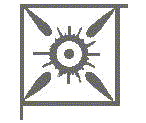 |
|
|
|
Plate 1b |
Plate 1b Black Printing
Plate 1 was put to service without hardening and as a result wore
quickly. Owing to the extreme wear, it was necessary to repair
all 240 plate impressions. Repair required re-entry, and it is believed
that the transfer roller from Plate 2 was used for this purpose.
The use of the Plate 2 transfer roller for the re-entry process had an
effect on the north-west corner star, giving it particular characteristics
which aid in the identification of this plate. It is believed that
the repair took place on 23 may 1840.
 |
|
|
|
Plate 1b |
Characteristics of Plate 1b Black Printing
| Earliest Known Date of Use | About 10 February 1841 |
| Flaw | NW 10 and 7 O'clock Rays |
| No Flaw | All Positions show Flaw |
| Non-Coincident Re-entry | CL, GA, GC, GK, GL, HK, ID, II, JI, JK, MH, MI, MK, NG, OI, QL |
| Double Letters | AE, CD, FA, FI, GI, MF, QA, TK |
| Burr Rubs | CF, DF, FD, NA, OB, OD, OF, PD, QD, RE |
| Recut Side Lines | Left Side: AJ, BJ, FH, GB, GF, HC, HL, IG, IH,
IJ, JJ, JL, KD, KF, KG, KH, KL, LA, LB, LL, MC, ME, MG, OD, OF,
PC, PD, PF, QG, RB, RD, RF
Right Side: KE, KL, LB, MD, TC |
| Recut Corners | BH, BL, FH, GB, HL |
| Constant Varieties | AL, IE, JB, PG, SI |
| Printing in Red | Plate 1c |
| Color of Maltese Cross | Red |
| Bleute Paper | Exists |
| Thin Paper | Exists |
| Inverted Watermark | Exists |
 |
 |
|
|
Plate 1b Red Printing
Matched Pairs Black and Red Printings
|
|
|
|
|
|
|
|
|
|
|
|
Note the weak letters "A" and "D" on the above Red Printings which
suggest that the check letters have been weakened by re-entry
Enlarged view of the Plate Dot at the south-west corner of Stamp TA
|
|
|
 |
|
|
Characteristics of Plate 1c Red Printing
| Earliest Known Date of Use | 12 June 1840 |
| Flaw | NW 10 and 7 O'clock Rays |
| No Flaw | All Positions show Flaw |
| Non-Coincident Re-entry | GA, GC, GK, GL, HK, ID, II, JI, JK, MH, MI, MK, NG, OI |
| Double Letters | AE, CD, FA, FI, GI,MF, QA |
| Burr Rubs | CF, DF, FD, NA, OB, OD, OF, PD, QD, RE |
| Recut Side Lines | Left Side: BJ, FH, GB, GF, HC, HL, IG, IH, IJ,
JJ, JL, KD, KF, KG, KH, KL, LL, MC, ME, MG, OD, OF, PC, PD,PF, QG,
RB, RD, RF
Right Side: KE, KL |
| Recut Corners | BH, BL, FH, GB, HL |
| Constant Varieties | IE, PG, SI |
| Printing in Red | Plate 1c State 2 and (State 3, 4 and 5 below) |
| Color of Maltese Cross | Black |
| Inverted Watermark | Exists But Uncommon |
 |
 |
|
|
Characteristics of Plate 1c Red Printing, State 3, Second Repair
| State 3 Impressions following the Second Repair | AA, AB, AD, AH, AI, AJ, AK, AL, BL,
CF, CG, CL, IB, IC, JA, JB, LA, LB, LC, MD, ND, PA, PL, QL, RA, RB, RL,
SA, SB, SC, SD, SE, SL, TA, TB, TC, TD, TE, TF, TG, TH, TI, TJ, TK, TL
Nearly all of these impressions show a faintness in the the check letters due to the use of a transfer roller with blank check letter squares being used to repair the impressions. |
Characteristics of Plate 1c Red Printing, State 3, Third Repair
| State 3 Impressions following the Second Repair | ID, JC, JD, JE, JF, JG, JI, KC, QC, QD, RG, RK, SG |
Characteristics of Plate 1d Red Printing, State 4, Third Repair
| State 4 Impressions
following the 3rd
State Repair |
QL, RL, TB, TG, TH, TJ, TK
This group shows faint re-entry marks in the top corner squares and faint check letters as well as restoration to the background at the bottom |
Characteristics of Plate 1e Red Printing, State 5, Fourth and Final Repair
| State 5 Impressions following the 4th Repair | QL, RL, TK,
This repair left more pronounced marks in the top corner squares and further weakened the check letters |